Artificial Intelligence In Renewable Energy Market Research, 2032
The global artificial intelligence in renewable energy market size was valued at $0.6 billion in 2022, and is projected to reach $4.6 billion by 2032, growing at a CAGR of 23.2% from 2023 to 2032.
Report Key Highlighters:
- The artificial intelligence in renewable market scope covers 20 countries. The research includes a segment analysis of each country in terms of value ($million) for the projected period 2023-2032.
- The study integrated high-quality data, professional opinions and analysis, and critical independent perspectives. The research approach is intended to provide a balanced view of global markets and to assist stakeholders in making educated decisions in order to achieve their most ambitious growth objectives.
- Over 3,700 product literature, annual reports, industry statements, and other comparable materials from major industry participants were reviewed to gain a better understanding of the market.
- The artificial intelligence in renewable energy market share is highly fragmented, with several players including Alpiq, AppOrchid Inc., ATOS SE, Enel Green Power, Enphase Energy, Flex Ltd., General Electric, Origami Energy Ltd., Siemens AG, and Vestas. Also tracked key strategies such as acquisitions, product launches, mergers, expansion, etc. of the players operating in the AI in renewable energy market.
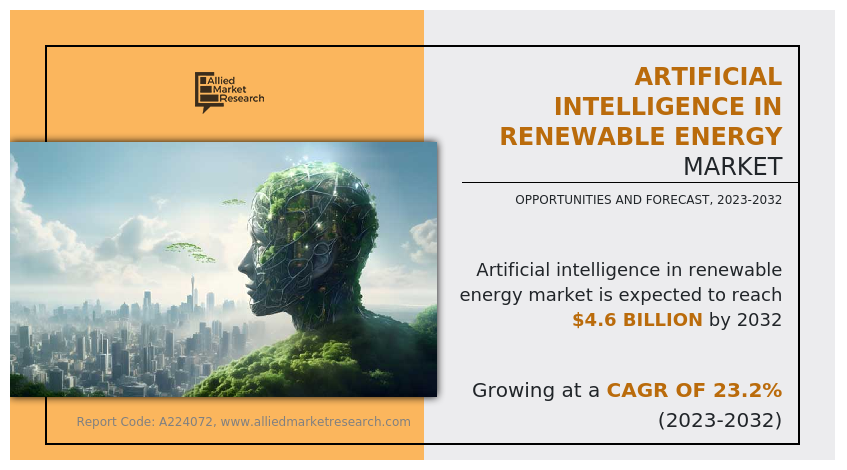
Artificial Intelligence in renewable energy industry is a cutting-edge technology that encompasses the development of computer structures capable of performing duties that usually require human intelligence, such as learning, reasoning, problem-solving, and decision-making. AI has made considerable strides in quite a number industries, inclusive of renewable energy, where its applications have the attainable to revolutionize the way to generate, distribute, and eat easy energy.
AI performs a pivotal function in the field of solar energy. It is used to enhance the efficiency of photo voltaic panels through monitoring the sun's motion and adjusting the panel's perspective accordingly. AI-driven algorithms analyze weather facts and predict cloud cover, allowing for better grid integration and power forecasting. Moreover, AI is used for predictive renovation of solar installations, lowering downtime and preservation costs.
Wind turbines benefit from AI purposes in numerous ways. Machine studying algorithms can optimize the alignment of wind turbine blades with changing wind directions, growing energy output. AI is also used for predictive maintenance, figuring out potential issues, and scheduling protection earlier than predominant breakdowns occur.
Hydropower plants use artificial intelligence to manage water flow and reservoir stages extra efficiently.
Artificial intelligence in renewable energy market can analyse weather forecasts, and can predict rainfall patterns and optimize dam operations to maximize energy technology while making sure flood control. This helps in balancing energy manufacturing with environmental considerations. AI is fundamental in the smart grid ecosystem. It permits real-time monitoring and control of the strength grid, making it greater resilient and responsive to fluctuations in supply and demand. AI algorithms can predict grid congestion, stability load distribution, and even discover and reply to cybersecurity threats.
AI-driven building administration structures assist optimize power consumption in residential, commercial, and industrial settings. These systems can modify heating, cooling, and lights based totally on occupancy and environmental conditions, main to full-size energy savings. Accurate energy forecasting is fundamental for planning and managing renewable energy assets effectively. AI models can analyze historical data, weather patterns, and different variables to supply relatively accurate predictions of power production, helping in grid stability and decreasing the need for backup electricity sources.
The rise of electric-powered automobiles is closely linked to AI in renewable energy market. AI is used in EV charging infrastructure to optimize charging schedules, manage peak demand, and integrate electric motors into the grid seamlessly. This synergy between AI, EVs, and renewable energy promotes a more sustainable transportation ecosystem. One of the primary functions of AI in EVs is optimizing charging schedules. AI algorithms take into account quite a number of factors, such as the driver's preferences, electricity prices, and grid demand, to determine the most cost-effective and convenient times for charging. When electricity rates are lower all through off-peak hours, AI can be used to schedule charging activities to align with these periods. Artificial intelligence not only lowers the price of charging however additionally encourages the use of smooth and renewable energy sources such as wind and solar power.
The artificial intelligence in renewable energy market growth is segmented into deployment type, component type, end-use industry, and region. On the basis of deployment type, the market is bifurcated into on-premises and cloud. On the basis of component type, the market is divided into solution, and service. On the basis of end-use industry, the market is classified into energy generation, energy transmission, energy distribution, and utilities. On the basis of region, the market is studied across North America, Europe, Asia-Pacific, and LAMEA.
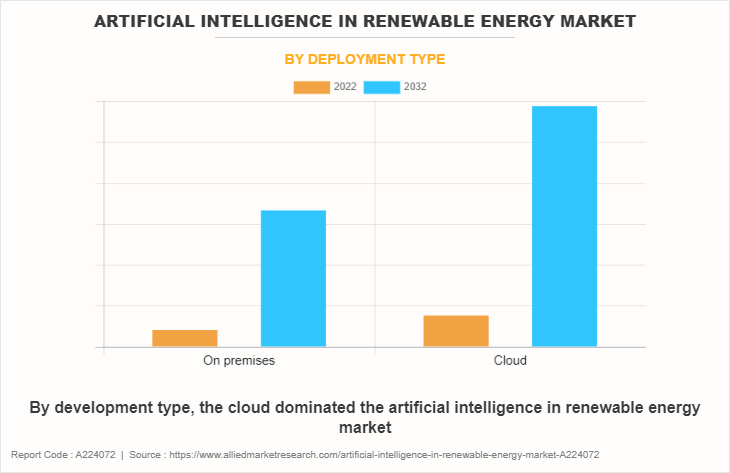
AI algorithms analyze historical climate data, strength consumption patterns, and other applicable facts to predict renewable power generation. This helps grid operators and power carriers control the integration of variable renewable sources into the grid extra efficiently. In cloud-based systems, AI can manage the distribution of renewable electricity in real-time. For instance, it can prioritize the usage of renewable strength when it is ample and cheap, and switch to different sources when needed, optimizing price and sustainability.
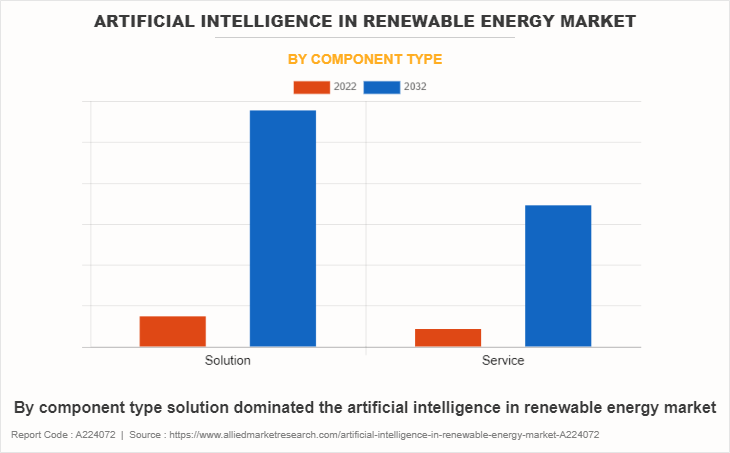
Artificial intelligence (AI) has made tremendous developments in the field of renewable power and is being used in various solutions to optimize energy production, storage, and distribution. AI is used to decorate the security of renewable power infrastructure by figuring out and responding to cyber threats and physical vulnerabilities. AI helps manage microgrids, which are localized energy systems that can operate independently or in conjunction with the primary grid. AI ensures environment-friendly strength distribution within microgrids.
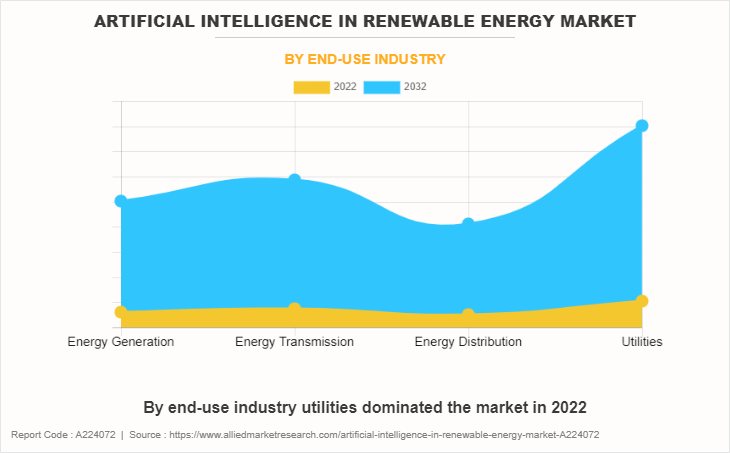
AI-driven energy management structures in utilities can modify energy manufacturing and consumption in real-time, optimizing the use of renewable sources and lowering reliance on fossil fuels. Utilities use AI-powered apps and services to engage clients in energy conservation efforts, helping them apprehend and minimize their electricity consumption. AI is used to enhance the cybersecurity of utility systems, protecting them from cyber threats and ensuring the reliability of renewable energy infrastructure.
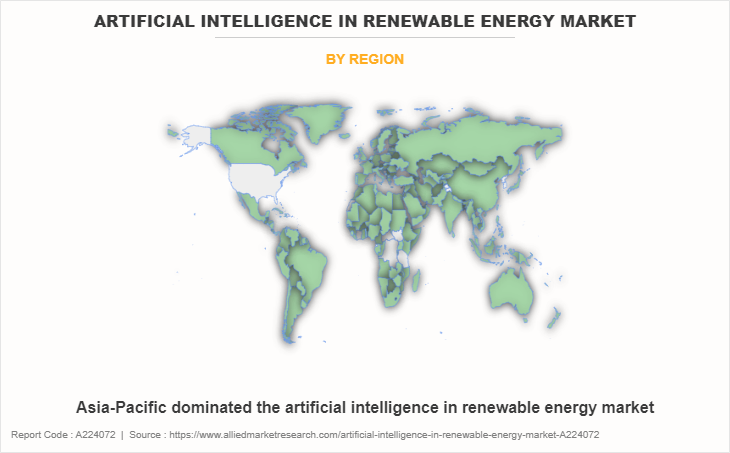
In the Asia-Pacific region, countries like China and India possess massive untapped wind energy potential. The effective harnessing of this workable depends closely on artificial intelligence (AI) applications. Machine learning algorithms play a pivotal function in this context by enabling the prediction of wind patterns and the dynamic adjustment of wind turbine orientations in real-time. This optimization process aims to maximize power output from wind farms. Additionally, AI contributes to the early detection of turbine faults, thereby minimizing downtime and reducing maintenance expenses.
The increase in the adoption of renewable energy technologies drives artificial intelligence in renewable energy market scope. AI plays an imperative role in optimizing renewable power production by analyzing historical and real-time data. It enhances power output by predicting and optimizing photo voltaic and wind power generation. AI-driven predictive maintenance detects and addresses possible issues in renewable infrastructure, minimizing downtime.
Machine learning algorithms improve power production forecasts, the usage of historical climate statistics, and performance metrics to useful resource grid operators and utilities in higher managing supply and demand, lowering reliance on backup electricity sources. In summary, AI-driven options bolster renewable electricity efficiency and reliability through records evaluation and forecasting. In July 2022, SAS and Basserah formed a partnership aimed at presenting advanced data analytics and AI solutions to companies in Saudi Arabia. Their primary focus inside this collaboration is on making use of records and robotics manner automation to discover growth possibilities in the renewable power quarter in Saudi Arabia.
The high cost of artificial intelligence-driven technologies is anticipated to hinder the growth of artificial intelligence in renewable energy market. The widespread adoption of artificial intelligence (AI) in renewable energy faces considerable barriers due to its high costs. Developing and imposing AI applied sciences in this area demands large investments in research and specialized expertise. Companies and research institutions ought to allocate tremendous resources to fund these initiatives.
Procuring and integrating AI hardware and software solutions is additionally expensive, requiring high-performance computing infrastructure and statistics series systems. Additionally, assembly regulatory and compliance necessities in the renewable energy region add to the economic burden. Addressing these value challenges is crucial for realizing AI's practicability in enhancing sustainability and efficiency in renewable energy. Overall, the high costs associated with AI-driven technologies in this region prevent their broader adoption and ought to be addressed to accelerate the development.
The major players operating in the global artificial intelligence in renewable energy market include Alpiq, AppOrchid Inc., ATOS SE, Enel Green Power, Enphase Energy, Flex Ltd., General Electric, Origami Energy Ltd., Siemens AG, and Vestas.
Apart from the above-listed companies, there are many more companies that manufacture artificial intelligence in renewable energy, which include SolarEdge, Inven Capital, Cypress Creek Renewables, E.ON, Pattern Energy, SunPower, Clearway Energy Group, Enel Green Power, First Solar, Nexamp, DeepMind, Suzlon Energy, Sierra Wireless, ABB, and others.
Key Market Trends:
- By development type, the cloud segment was the highest revenue contributor accounting for more than half of the market share in 2022.
- By component type, the solution segment was the highest revenue contributor accounting for almost two-thirds of market share representing 32.0% of CAGR in 2022.
- By end-use industry, the utilities segment was the highest revenue contributor to the market, representing 22.8% of CAGR in the market.
- By region, Asia-Pacific was the highest revenue contributor, accounting for two-thirds of the global market in 2022.
Key Benefits For Stakeholders
- This report provides a quantitative analysis of the market segments, current trends, estimations, and dynamics of the artificial intelligence in renewable energy market analysis from 2022 to 2032 to identify the prevailing artificial intelligence in renewable energy market opportunities.
- The market research is offered along with information related to key drivers, restraints, and opportunities.
- Porter's five forces analysis highlights the potency of buyers and suppliers to enable stakeholders make profit-oriented business decisions and strengthen their supplier-buyer network.
- In-depth analysis of the artificial intelligence in renewable energy market forecast assists to determine the prevailing market opportunities.
- Major countries in each region are mapped according to their revenue contribution to the global market.
- Market player positioning facilitates benchmarking and provides a clear understanding of the present position of the market players.
- The report includes the analysis of the regional as well as global artificial intelligence in renewable energy market trends, key players, market segments, application areas, and market growth strategies.
Artificial Intelligence in Renewable Energy Market Report Highlights
| Aspects | Details |
| Market Size By 2032 | USD 4.6 billion |
| Growth Rate | CAGR of 23.2% |
| Forecast period | 2022 - 2032 |
| Report Pages | 242 |
| By Deployment Type |
|
| By End-Use Industry |
|
| By Component Type |
|
| By Region |
|
| Key Market Players | Siemens AG, Enel Spa, General Electric, Atos SE, Alpiq Holding Ltd., Origami, App Orchid, Vestas, Enphase Energy, Flex Ltd. |
Analyst Review
According to the opinions of various CXOs of leading companies, the artificial intelligence in renewable energy market is driven by rise in solution based renewable energy. AI can optimize the distribution and transmission of renewable energy. It can make real-time decisions on routing electricity from various sources to where it's needed most efficiently. This reduces energy wastage and improves grid stability.
AI-Powered advancements in renewable energy efficiency drive the growth of artificial intelligence in renewable energy market. AI algorithms are increasingly being utilized in renewable energy systems to predict maintenance needs, enhancing operational efficiency and preventing downtime. Managing smart grids AI models improve the accuracy of energy generation predictions from sources such as solar and wind, aiding grid operators in managing energy supply and demand effectively, thereby reducing wastage. Additionally, AI plays a vital role in smart grid management, ensuring a stable energy supply by balancing distribution between renewable sources and traditional power plants in real-time.
High cost of artificial intelligence-driven technologies hinders the growth of the artificial intelligence in renewable energy market. The high cost of AI-driven technologies in renewable energy is a major obstacle to their widespread adoption. Developing and implementing AI in this field demands substantial investments in research, specialized expertise, and expensive hardware and software. Companies and research institutions must allocate significant resources to fund these initiatives, including high-performance computing infrastructure and necessary sensors and hardware.
The Asia-Pacific region is projected to register robust growth during the forecast period. China is a leader in the adoption of AI for renewable energy. It uses AI for optimizing wind and solar farm operations, forecasting energy generation, and managing grid stability. Chinese companies are also developing AI-powered electric vehicle (EV) charging networks. China utilizes AI for energy forecasting and optimizing its grid system. AI-driven smart grids help balance the intermittent nature of renewable energy sources like solar and wind.
Asia-Pacific is the largest region in the artificial intelligence in renewable energy market.
The leading end-use industry of artificial intelligence in renewable energy market includes energy generation, energy transmission, energy distribution, and utilities.
AI-Driven optimization for enhanced energy storage systems and smart grid energy distribution and storage are the upcoming trends of artificial intelligence in renewable energy market in the world.
The energy distribution is the fastest growing segment by the end-use industry in the artificial intelligence in renewable energy market.
Increase in adoption of renewable energy technologies and AI-Powered advancements in renewable energy efficiency are the driving factors of artificial intelligence in renewable energy market.
The major players operating in the global artificial intelligence in renewable energy market include Alpiq, AppOrchid Inc., ATOS SE, Enel Green Power, Enphase Energy, Flex Ltd., General Electric, Origami Energy Ltd., Siemens AG, and Vestas.
The global artificial intelligence in renewable energy market size was valued at $0.6 billion in 2022, and is projected to reach $4.6 billion by 2032, growing at a CAGR of 23.2% from 2023 to 2032.
Loading Table Of Content...
Loading Research Methodology...



